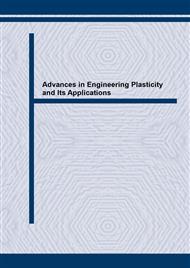[1]
Wai R., Lo K.Y. and Rowe R.K. ,Thermal stress analysis in rock with nonlinear properties. Int. J Rock Mech. Min .Sci. & Geomech.Absir.,1982(19):211-220.
DOI: 10.1016/0148-9062(82)90219-4
Google Scholar
[2]
Simpson C.Deformation of granitic rock across the brittle-doctiletransition [J] J. Struc Geol 1985 (7):503-511
Google Scholar
[3]
Jingtao Wang, Aiguo Zhao, Mingchang Huang, The high temperature effect on rapture temper for granite[J]. Chinese Journal of geotechnical engineering, 1989, 6(11):113-118. 0 200 400 600 800 -0.4 -0.2 0.0 0.2 0.4 Poisson's ratio temperature(oc) 0 200 400 600 800 0 10 20 30 40 elastic modulus(GPa) temperature( O C) Fig.10(b) change of Poisson's ratio Fig.10(a) change of deformation modulus
Google Scholar
[4]
Lau J.S.O. Gorski B.and Jackson R.,The effects of temperature and water-staturational on mech- anical properties of Lac du Bormet pink granite.8Int.Con.On RockMech. Tokyo, Japan, 1995.
Google Scholar
[5]
Daoying Xi, the effect of temperature on modulus and wave velocity of rock, Chinese Journal of rock mechanics and engineering.1998, 17(supplement): 802-807.
Google Scholar
[6]
Xu Xichang Liu Quansheng A preliminary study on basic mechanical properties for granite at high temperature .Chinese Journal of geotechnical engineering, 2002, 22(3): 276-278.
Google Scholar
[7]
Xichang Xu, A pilot study on mechanical properties and damnify characteristic for granite in three gorge reservoir area on the effect of high temperature[C], rock mechanics graduate school of Chinese Academy of Sciences in Wu Han 2000.
Google Scholar
[8]
Mingyang Wang, Dongjin Yan, Qihu Qian, the discuss about the whole course curve of rock single axial compress, Chinese Journal of rock mechanics and engineering,1998, 17(1): 101106.
Google Scholar
[9]
Hwueckel T.,Pellegrint R.,A constitutive law for thermo-plastic behaviors of rock sand analogywithclays[J].Surveys in Geophys,15(4):643-671,1994. Organization of the Text Section Headings. The section headings are in boldface capital and lowercase letters. Second level headings are typed as part of the succeeding paragraph (like the subsection heading of this paragraph). Page Numbers. Do not print page numbers: Please number each sheet toward the middle near the bottom (outside the typing area) with a soft pencil. Tables. Tables (refer with: Table 1, Table 2, ...) should be presented as part of the text, but in such a way as to avoid confusion with the text. A descriptive title should be placed above each table. The caption should be self-contained and placed below or beside the table. Units in tables should be given in square brackets [meV]. If square brackets are not available, use curly {meV} or standard brackets (meV). Figures. Figures (refer with: Fig. 1, Fig. 2, ...) also should be presented as part of the text, leaving enough space so that the caption will not be confused with the text. The caption should be self-contained and placed below or beside the figure. Generally, only original drawings or photographic reproductions are acceptable. Only very good photocopies are acceptable. Utmost care must be taken to insert the figures in correct alignment with the text. Half-tone pictures should be in the form of glossy prints. If possible, please include your figures as graphic images in the electronic version. If TTP is required to scan and insert images, please keep the following points in mind: (a) the allotted space (for inserting illustrations) must exactly match the space made available in the camera-ready version, so that the electronic version is identical to the hard copy with regard to page and line breaks. (b) the required positioning of any high-quality separate illustration must be clearly indicated on its reverse side. The size of the illustrations must exactly match the space left in the camera-ready manuscript. Equations. Equations (refer with: Eq. 1, Eq. 2, ...) should be indented 5 mm (0.2"). There should be one line of space above the equation and one line of space below it before the text continues. The equations have to be numbered sequentially, and the number put in parentheses at the right-hand edge of the text. Equations should be punctuated as if they were an ordinary part of the text. Punctuation appears after the equation but before the equation number, e.g. c 2 = a 2 + b 2. (1) Literature References References are cited in the text just by square brackets [1]. (If square brackets are not available, slashes may be used instead, e.g. /2/.) Two or more references at a time may be put in one set of brackets [3,4]. The references are to be numbered in the order in which they are cited in the text and are to be listed at the end of the contribution under a heading References, see our example below. Summary On your floppy disk, please indicate the format and word processor used. Please also provide your phone number, fax number and e-mail address for rapid communication with the publisher. Please always send your disk along with a hard copy that must match the disk's content exactly. If you follow the foregoing, your paper will conform to the requirements of the publisher and facilitate a problem-free publication process. References
Google Scholar
[1]
Dj.M. Maric, P.F. Meier and S.K. Estreicher: Mater. Sci. Forum Vol. 83-87 (1992), p.119
Google Scholar
[2]
M.A. Green: High Efficiency Silicon Solar Cells (Trans Tech Publications, Switzerland 1987).
Google Scholar


